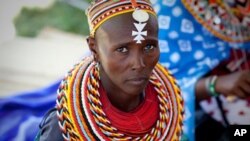Colombian coffee growers mingle with Peace Corps volunteers and some of the nation’s finest rhythm and blues musicians at this year’s Smithonian Folklife Festival, held on the National Mall in Washington, D.C.
This year’s event spotlights Colombia’s rich bio-cultural diversity, the 50th anniversary of the Peace Corps and the powerful influence of rhythm and blues music in American popular culture.
Hundreds of participants come to the nation’s capital for the 10-day event, which generally draws about a million visitors, according to Smithsonian spokesperson Becky Haberacker.
“The festival is a way to showcase cultural traditions from around the world,” she says. "And it’s a way to allow people to share their culture and their experience.”
This is the 45th folklife festival to be held on the National Mall, a wide expanse of open space between the U.S. Capitol building and the Lincoln Memorial which is lined with museums. White tents set up on the mall house an eclectic assortment of programs and exhibits, including craft and cooking demonstrations as well as concerts.
"My favorite part is seeing things from other countries and listening to music," says Jim Yuengert, who works nearby. "It's a great opportunity to showcase things going on worldwide and within the U.S. and to open people's minds."
The Peace Corps program includes dance demonstrations from Ukraine, Botswana and the Philippines along with food samples from Morocco, Peru and Ghana. One of the most popular events, which occurred early in the festival, was a rhythm and blues performance by the musical group Soul Train. In the Colombia section, visitors can witness a ceremonial Amazonian dance or sample sweet corn arepas.
"It's very nice to show the kids and everybody how people in Colombia live," says Henry Rodriquez. A native of Bogota who now lives in Virginia, he brought his 19-year-old daughter to the festival. "It's very important for the new generation to see their background, to see their roots."
This first-hand cultural exchange is at the heart of the folklife festival experience.
“Instead of visiting an exhibit someone else has done, this is done in the first person,” says Haberacker. “Visitors are hearing directly from the tradition bearers; the people who make the crafts, who cook the food or sing the songs.”
Although the event draws visitors from around the world, most who attend come from around the United States.
Phil Jones made the trip from North Carolina. Having lived abroad for over a decade, it's a way for him to reconnect with other cultures again.
"Until you speak someone's language, eat with them, pray with them, you understand nothing about the rest of the world and your own culture," says Jones. "Americans fear other cultures because they don't know anything about them. They are more alike than different and when you see them, you're less likely to be mistrustful or wary of other cultures."
This spirit of mutual cultural understanding is exactly what Smithsonian organizers hope people gain from the experience, especially since many who attend won't have a chance to visit the foreign countries they learn about at the festival.
“We hope people walk away with a better appreciation of cultures from around the world and at the same time share a bit of America or wherever they’re from with the participants,” says Haberacker. “So it’s a bit of a cultural exchange we hope people come away with.”







